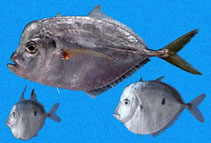| Family: |
Carangidae (Jacks and pompanos), subfamily: Caranginae |
| Max. size: |
40 cm TL (male/unsexed) |
| Environment: |
benthopelagic; marine; depth range 0 - 50 m |
| Distribution: |
Eastern Pacific: Redondo Beach in southern California, USA to Peru; rare north of Baja California, Mexico. |
| Diagnosis: |
Body very short, deep, and compressed; lower branch of first gill arch with 30 to 35 gill rakers; dorsal fin with 8 spines followed by another spine and 21 to 24 soft rays (VIII1, 21-24); anterior lobe of second dorsal and anal fins not elongated in adults; anterior dorsal spines prolonged in juveniles; body scaleless; lateral line scutes very weak and poorly differentiated; body silvery to gold with metallic blue highlights; juveniles silvery, with a dark oval stain on the straight part of the lateral line (ref. 55763). |
| Biology: |
Adults are found in coastal waters up to at least 50 m depth (Ref. 9283). They generally form schools near the bottom (Ref. 9283). Juveniles are encountered near the surface (Ref. 9283). They feed on small fishes and crustaceans (Ref. 9283). Marketed fresh and salted or dried (Ref. 9283). |
| IUCN Red List Status: |
Least Concern (LC); Date assessed: 30 April 2008 Ref. (130435)
|
| Threat to humans: |
harmless |
Source and more info: www.fishbase.org. For personal, classroom, and other internal use only. Not for publication.
